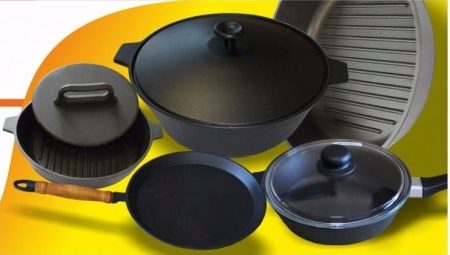Since Soviet times, cast iron dishes have been valued in the kitchen. At some point, non-stick modern pans nearly displaced heavy cast-iron appliances from Russian cuisine. However, they managed to resist, because their quality has been tested for decades.
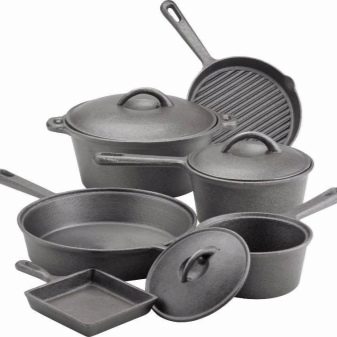
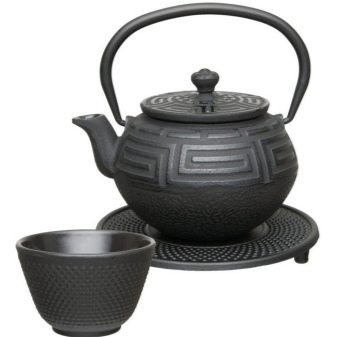
Features
Cast iron cookware is one of the universal options thanks to which it is possible to cook both tasty and healthy food. Such pans have a long service life, and some grandmothers can find real rarities: pans preserved from the old times.
If the dishes have an internal enamel coating, then the food can be stored for a long time in the refrigerator. If this is not available, then it is better to move the food to another container, as the products can cause corrosion on the surface and spoil the dishes.


Varieties
At present, modern technologies allow us to improve and refine the already practical and convenient cast-iron utensils. More and more varieties can be found in the market. Each option is adapted to the modern conditions of the kitchen and is designed to work in conjunction with certain household appliances.
- For induction cookers. The raw material from which cast iron cookware is made has the property of attracting magnets, which means that it can be used to work on an induction cooker. Now most heat-resistant containers are available with a flat bottom, which is very important when cooking dishes on an induction stove - cast-iron dishes also have no problems with this.
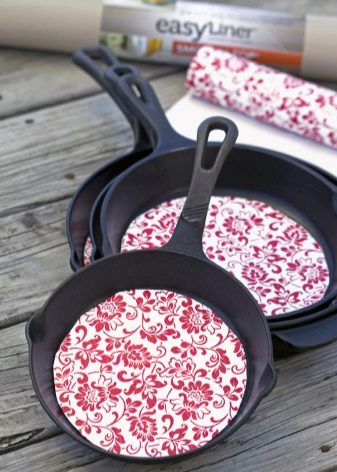
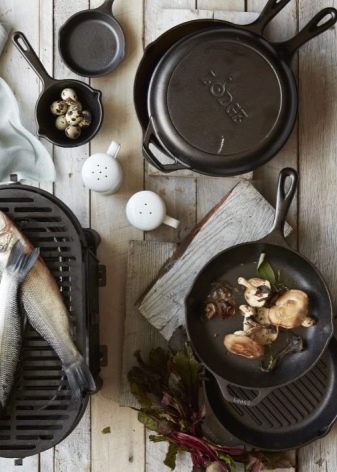
- Enameled dishes. This option is also quite suitable for frying on an induction cooker.Typically, these pans are enameled both inside and out. External features allow you to choose dishes of a certain color, which will harmoniously fit into the design of the kitchen interior. Inside, the devices are finished with glass enamel, which is absolutely safe for products even with direct contact. The advantage of enameled specimens is the ability to store the dish longer. Also, unlike classic cast iron appliances, enameled dishes do not need to be prepared and baked several times after purchase.
However, there are also disadvantages: such pans have a limited service life.

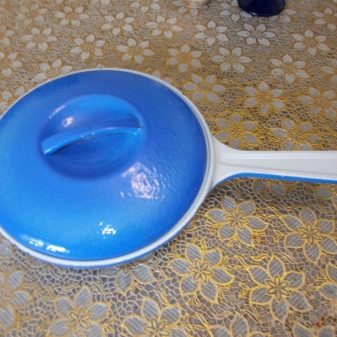
- Teflon-coated cookware. This is another option with a protective layer. Such dishes are a budget model in comparison with enameled, and its service life is even less. In this case, a protective coating is applied only to the inside. In this regard, the service life is limited to 3-4 years. As soon as Teflon began to move away from the walls, the use of a pan becomes impossible.
This is not the most successful variety of cast-iron cookware, although at first it seems to the housewives that cooking in it is more convenient and quick, because Teflon has non-stick properties, which preserves the maximum benefit in the products. In fact, it is more difficult to take care of the Teflon coating, in addition, you need to work with it very carefully and not damage the walls or the bottom with a metal spatula.
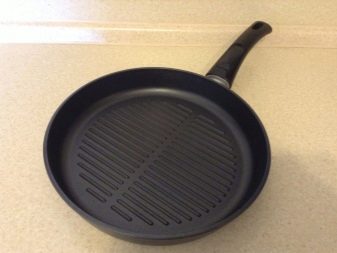

You can classify cast-iron utensils into objects of a narrower focus. For example, for cooking in the oven, cast irons or cast-iron pots can be used, cast-iron fryers, cast-iron pots, boilers, cauldrons, ducklings, portioned pans and other kitchen utensils that facilitate the life of a young housewife are popular.
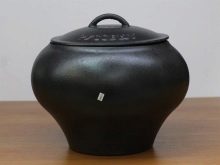
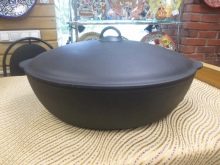
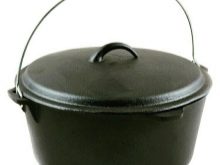
Advantages and disadvantages
The most famous cooks make their choice in favor of cast-iron cookware for a number of reasons. They are described below.
- This is an environmentally friendly glassware that does not do any harm to the health of consumers. In the manufacture of cast iron products, no chemical elements are used, and non-stick properties are achieved naturally in the cooking process.
- One such pan serves more than one decade and can accompany the life of several generations. There is no need to look after her in any special way - just cleaning and calcining is enough to make her look like new again.
- The porous structure of the material slowly heats up, but reliably retains heat and evenly distributes it over the entire area. For this reason, in comparison with aluminum or steel pans, the dish is cooked at higher temperatures.
- These are universal examples that allow you to cook food on a gas, electric or glass ceramic stove, bake in the oven, cook, fry, stew.
- As already noted, uniform heating is typical for such pans, and this ensures the same heating of dishes on each side. Well-cooked food is tastier and healthier than light-fried foods.
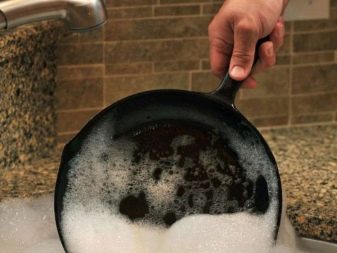
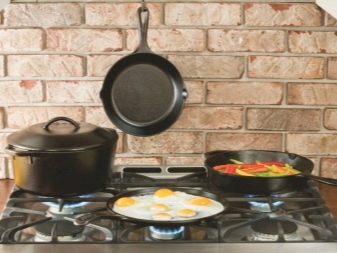
Before buying such dishes, you should familiarize yourself with its shortcomings.
The main disadvantage of the cast-iron pan is its heavy weight. On average, one copy weighs about 2 kg. Not every housewife can hold a heavy object in her hands, especially when it is often necessary to lift it, for example, when making pancakes. In this regard, the dishes may fall to the floor, and cracks may form on the coating, and sometimes a piece will completely fall off.
For this reason, iron cookware must be operated very carefully. With the same caution, it is worth approaching both her departure and storage.
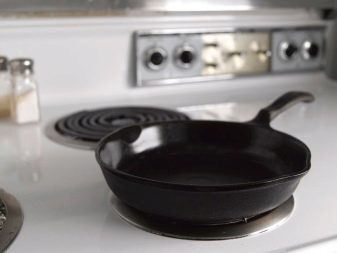

How to choose?
When choosing cookware made of cast iron, it is worth following some recommendations.
It is necessary to decide why do you need a purchase. You can, of course, buy a universal pan that perfectly fries, stews, bakes, but it is better to purchase objects of a narrow focus: ducklings, crepe makers, cauldrons.Such a purchase will avoid thorough washing after each preparation. In addition, the service life of kitchen utensils will increase several times.
If a pan was required for pancakes, then you need to choose a thin dish, for frying meat products you need a container with a corrugated bottom, for stewing - a deep container. Do not forget that heavy dishes are characterized by heavier weight.
In addition, it needs the most powerful stove. Often there are difficulties when choosing a cast iron cauldron. The flat-bottom capacity is more stable, but its walls will heat worse
. The product with a round bottom allows you to equally warm the dish from all sides, but it requires a special stand on the stove, so it is recommended to use it on an open fire.
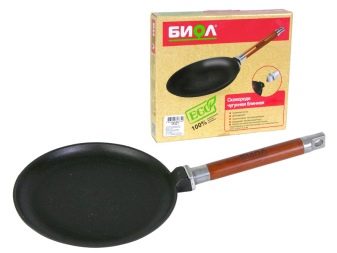
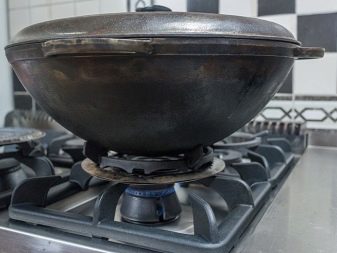
You need to pay attention to the material from which the dishes are made. Varieties of cast-iron products have been described above, and it can be concluded that pans with an additional coating are much more convenient and also look aesthetically pleasing. But still, a classic frying pan, simply cast from cast iron, is more practical, as it is durable.
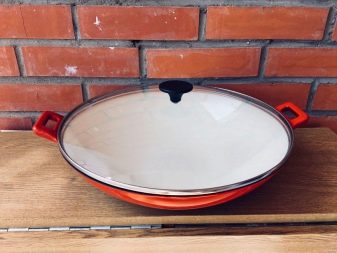
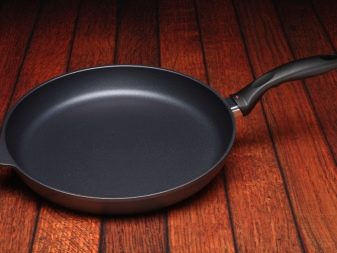
You should carefully examine your favorite products. for defects. Flaws in cast iron are rare, but they also have a place to be. Such scratches not only spoil the appearance, but also reduce the service life of the dishes. Defects can be observed not only on cheap products, but also on more expensive ones.
It is worth exploring the chosen thing on each side. No need to take products that show at least a small crack or an attempt to melt the marriage. This should be a smooth and high-quality polished coating without sagging and indentations.
On enameled specimens, you can sometimes find not only scuffs and scratches, but also swellings - these signs also indicate poor-quality goods that will become unusable very quickly.
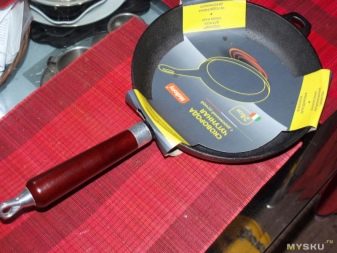
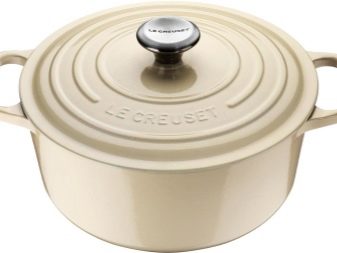
Need to pay attention and on product handles. They are removable and non-removable and can be made of cast iron, wood or polymeric materials. Cast handles make it possible to cook a dish in the oven, but under the influence of heat they become very hot, and without a thick towel the housewife will be unable to get dishes from the oven.
Wooden handles in this regard are more convenient, since they do not heat up and are environmentally friendly, but their service life is very limited. You cannot put a pan with wooden handles in the oven. But if these are removable products, then they will allow you to use the pan even when baking. The polymer handles do not heat up and allow you to work with the oven, but if handled carelessly, they may break off.
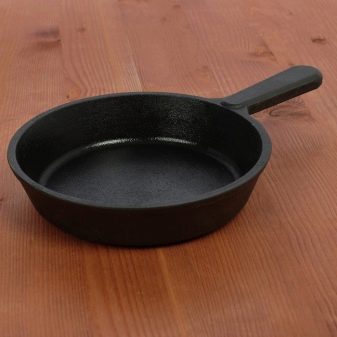
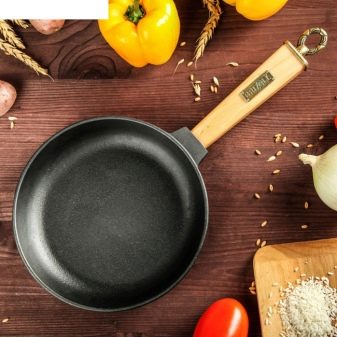
Important and cap. For example, cast-iron pots, cauldrons or ducklings are already sold in advance complete with covers. Frying pans and roasters are usually sold without lids, but perhaps this is the plus of such products. The buyer does not have to overpay for this attribute, because a suitable size lid may already be in his kitchen.
If the cover is bought separately, it is better to refuse to purchase goods from cast iron. Cast iron lids are very large, heavy and have the ability to remove heat, adversely affecting cooking.
It is better to give preference to glass covers, since they have less pronounced heat-conducting properties, moreover, it is more convenient to control the cooking process through them.
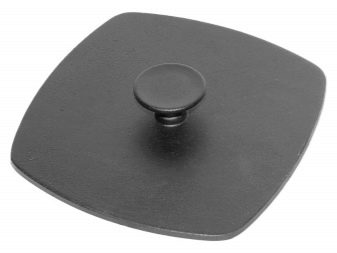
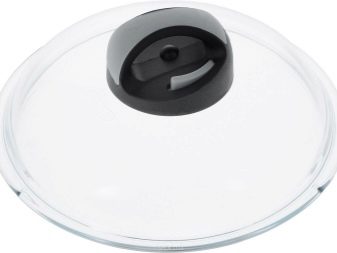
According to customer reviews, you can make a rating of the most popular manufacturers of cast iron cookware. Leading places in it are occupied by such manufacturers as “BIOL”, “Siton”, “Balezino”, “Slutsk”.
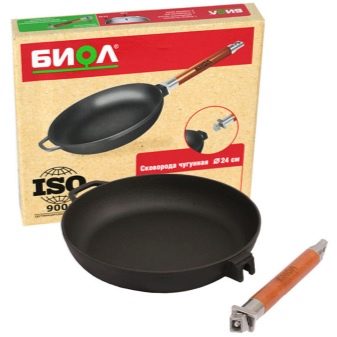
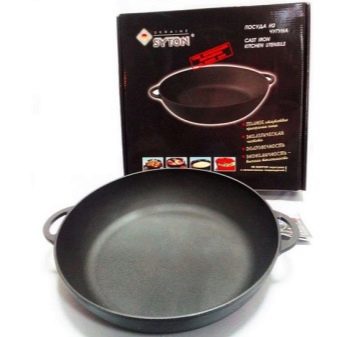
Subtleties of use
A fully cast-iron pan without an additional protective layer has its own application features. Before its first use, a number of measures must be taken that will achieve the maximum service life. An important step when using cast iron is calcination.The dishes that have been baked will not allow the dish to burn and fill the food with excellent taste and aroma. Prepare the cast-iron product for operation as described below.
- First of all, you need to thoroughly rinse the frying pan brought from the store with detergent and wipe it dry.
- After that, it should be baked in the oven.
- Then you need to cool the dishes.
- The next step is to pour salt into the bottom and repeat the calcination procedure. Do not regret salt - it will take about 1 kg depending on the volume of the container.
- Then you need to cool the dishes again.
- The next step is to calcine the empty pan for the last time.
- After this, it is necessary to grease the still hot containers with oil and leave in a preheated oven for several hours. Now the dishes are ready to go.
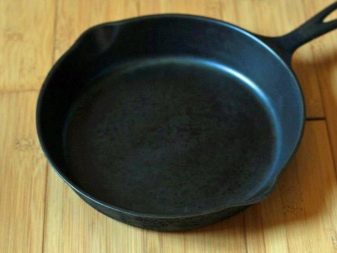
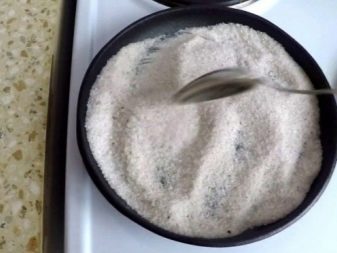
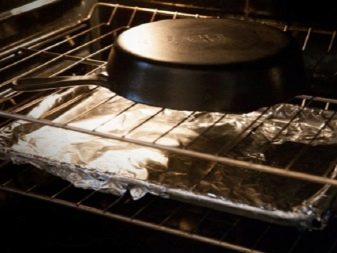
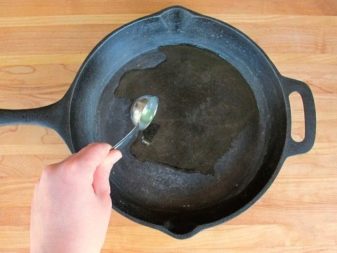
Initial preparation is necessary in order for the pan to receive non-stick properties. After such a thorough treatment, the container is less oxidized under the influence of products and is used for a long time and in high quality in the kitchen.
Care and storage
Not all housewives are satisfied with the food cooked in cast iron. This happens if the dishes are not properly operated. It is important to wash the cast pan immediately after it has cooled. If you leave it for several days, the oil will be absorbed into the pores and transferred to the next dish, which will change its taste and aroma. You can take advantage of a few more recommendations for the operation and maintenance of cast iron products.
- The cooking process should only be done on low heat.
- Once the cooked dish has cooled, it is important to transfer it to another container.
- Wash cast iron products with hot water, and then wipe dry.
- After washing, it is necessary to rinse the bottom with boiling water and grease with oil. In this form, a cast-iron frying pan should be stored - the oil creates a protective barrier against corrosion.
- Cast iron cookware cannot be soaked, as it quickly rusts. Cast iron utensils should be inspected regularly for rust.
- When washing, coarse brushes and aggressive chemicals cannot be used, since these products can severely damage the protective coating, and its restoration will be quite problematic. In addition, household chemicals can be absorbed into the pores of the material. For the same reason, it is not recommended to wash such pans in a dishwasher.
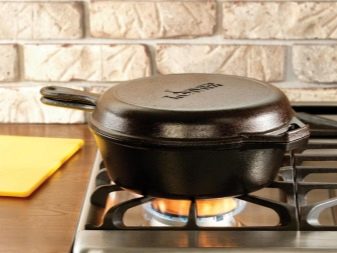
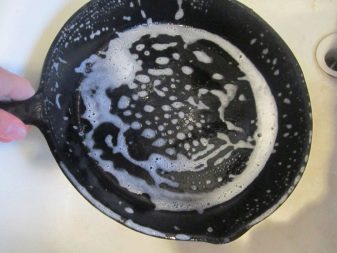
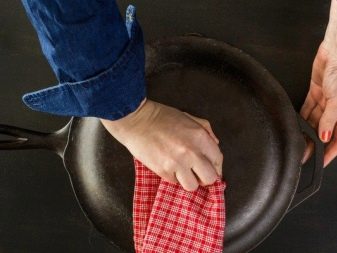
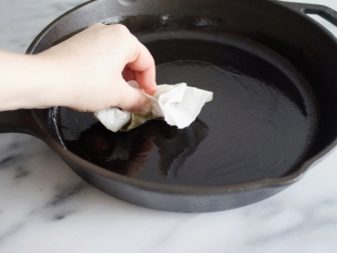
Special care requires cast iron cookware with enamel coating. No need to cool such an instance under cold water - let it cool on its own. If the enameled frying pan was placed in the refrigerator, then when heating it is important to wait until the dish has cooled a little. If you allow a strong temperature difference, then on enamel, which is already not very durable, damage will occur. In order not to wait until the dishes with food, taken out of the refrigerator, reach room temperature, it is easier to transfer the dish to another container and warm it up.
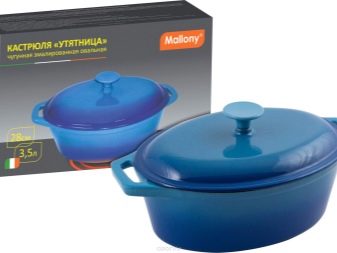
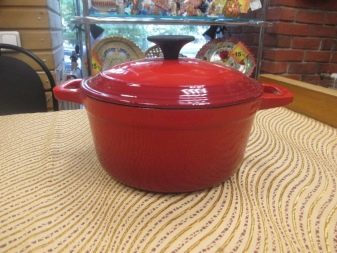
For how to properly care for cast-iron utensils, see the next video.
